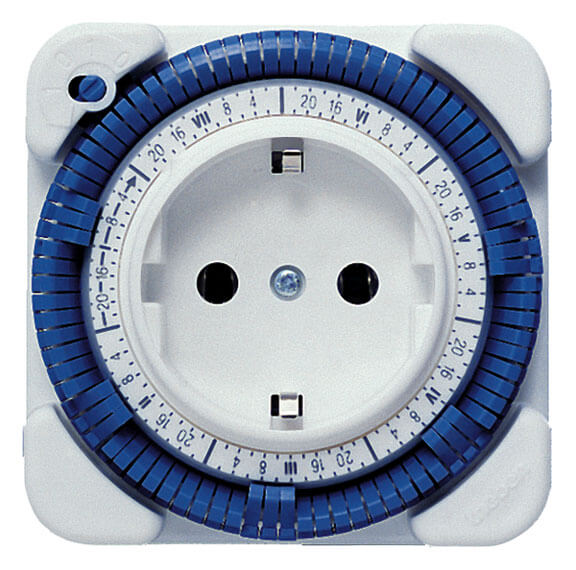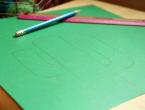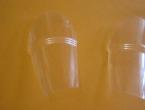Types of electrical plugs and sockets. Types and types of sockets: from classic designs to modern multifunctional models Types of sockets 220
Of the many connections, there are 13 most commonly used types of sockets, designated by Latin letters from A to M.

Type A 
This type is designated Class II. The plug consists of two parallel contacts. In the Japanese version, the contacts are the same size. In American, one end is slightly wider than the other. Devices with a Japanese plug can be used in American outlets, but vice versa will not work.
Type B 
Used in North and Central America and Japan.
This type is designated as Class I. The international designation of the American type B is NEMA 5-15, the Canadian type B is CS22.2, n°42 (CS = Canadian Standard). The maximum current is 15 A. In America, type B is very popular; in Japan it is much less common. Often, residents of old houses with type A sockets, when purchasing new modern electrical appliances with type B plugs, simply “bite off” the third grounding contact.
Type C 
Used in all European countries except Great Britain, Ireland, Cyprus and Malta.
International designation - CEE 7/16. The plug consists of two contacts with a diameter of 4.0-4.8 mm at a distance of 19 mm from the center. The maximum current is 3.5 A. Type C is an outdated version of the newer types E, F, J, K and L, which are now used in Europe. All Type C plugs fit perfectly into the new sockets.
Type D 
Used in India, Nepal, Namibia and Sri Lanka.
The international designation is BS 546 (BS = British Standard). Represents an obsolete British style plug, which was used in the mother country until 1962. The maximum current is 5 A. Some Type D sockets are compatible with Type D and M plugs. Type D sockets can still be found in older homes in Great Britain and Ireland.
Type E 
Used mainly in France, Belgium, Poland, Slovakia, Czech Republic, Tunisia and Morocco.
International designation - CEE 7/7. The maximum current is 16 A. Type E is slightly different from CEE 7/4 (type F), which is common in Germany and other central European countries. All Type C plugs fit perfectly into Type E sockets.
Type F 
Used mainly in Germany, Austria, the Netherlands, Sweden, Norway, Finland, Portugal, Spain and Eastern European countries.
International designation CEE 7/4. This type is also known as "Schuko". The maximum current is 16 A. All type C plugs are ideally suited to type F sockets. The same type is used in Russia (in the USSR it was designated as GOST 7396), the only difference is that the diameter of the contacts adopted in Russia is 4 mm, in while in Europe, contacts with a diameter of 4.8 mm are most often used. Thus, Russian plugs easily fit into wider European sockets. But the plugs of electronic devices made for Europe do not fit into Russian sockets.
Type G 
Used in the UK, Ireland, Malaysia, Singapore, Hong Kong, Cyprus and Malta.
The international designation is BS 1363 (BS = British Standard). The maximum current is 32 A. Tourists from Europe visiting the UK use regular adapters.
Type H 
Used in Israel.
This socket is identified by SI 32 symbols. The Type C plug is easily compatible with the Type H socket.
Type I 
Used in Australia, China, New Zealand, Papua New Guinea and Argentina.
International designation - AS 3112. Maximum current - 10 A. Sockets and plugs of types H and I do not fit together. The sockets and plugs used by people in Australia and China fit together well.
Type J 
Only used in Switzerland and Liechtenstein.
The international designation is SEC 1011. The maximum current is 10 A. Regarding type C, the type J plug has one more contact, and the socket has one more hole. However, Type C plugs will fit into Type J sockets.
Type K 
Only used in Denmark and Greenland.
International designation - 107-2-D1. The Danish socket is suitable for CEE 7/4 and CEE 7/7 plugs, as well as type C sockets.
Type L 
Used only in Italy and very rarely in North African countries.
International designation - CEI 23-16/BII. Maximum current - 10 A or 16 A. All type C plugs fit into L type sockets.
Type M 
Used in South Africa, Swaziland and Lesotho.
Type M is very similar to Type D. Most Type M sockets are compatible with Type D plugs.
When it comes to electricity, globalization can be forgotten. Even in the European Union, where there is one currency, there are different electrical outlets. Therefore, when going abroad, you have to replenish your luggage with an adapter or look for it upon arrival. The reason for this is the historical factor.
In the era of electrification, inventors from different countries offered their own versions of optimal sockets; Different types of power generators were built all over the world. And national companies involved in the installation of electrical networks supplied their devices suitable for these networks. Accordingly, different types of plug connectors and sockets were introduced and their own networks were designed. The developments of other countries were completely ignored.
Influenced the development of sockets and the availability of materials. For example, during World War II, Britain came up with a three-prong plug with a short copper fuse. This design made it possible to save copper reserves for military needs.
Now, according to one classification, there are 12 types of sockets, according to another - 15. Moreover, sockets of one type sometimes accept plugs of another. However, if you find out that the country you are going to has the same type of socket as at home, don’t rush to rejoice! This is only half the problem. Voltage and frequency may vary in different parts of the world.
Classification of types of sockets and plugs in different countries of the world

The two most common standards are: European - 220–240 V at a frequency of 50 Hz and American - 100–127 V at a frequency of 60 Hz. You should not check what will happen if an electrical appliance operating on 100–127 V is plugged into an outlet with 220–240 V.
In some countries you should keep your ears open. For example, in most parts of Brazil, 127 V is used, but in the north of the country 220 V is found. And in Japan, the voltage is the same everywhere - 110 V, but the frequency is different: in the east 50 Hz is used, in the west - 60 Hz. The reason is simple: first, German-made generators with a frequency of 50 Hz were purchased for Tokyo, and soon after that American ones with a frequency of 60 Hz were supplied to Osaka.
Perhaps someday a single standard will be adopted. A universal socket for all types of plugs has already been developed. But for now it’s up to everyone to install it or not. In addition, we first need to come to a unified voltage standard. And this comes down to huge financial costs for the refurbishment and re-equipment of transformer substations, replacement of sockets and plugs.
* Voltage 100–127 V at a frequency of 60 Hz is used by the USA, Canada, Japan, Mexico, Cuba, Jamaica, partially Brazil and other countries.
* Voltage 220-240 V with a frequency of 50 Hz is used in most other countries, but even with the same parameters, the type of sockets can vary greatly.
Here is a brief description of some of them: Types A and B - American socket
Type B differs from A by the presence of a third hole - it is intended for a grounding pin. Such sockets, as you can guess from the name, were invented in the USA and are widespread in North, Central and partly South America, as well as Japan and some other countries.
Types C and F - European socket
Just like A and B, types C and F differ from each other only in the presence of grounding - F has it. The European socket is used in most EU countries, as well as in Russia and the CIS, Algeria, Egypt and many other countries.
Type G - British socket
In the UK, the socket has three flat holes, and this design appeared for a reason. The fact is that during World War II the country experienced a copper shortage. Therefore, a plug with a short copper fuse and three pins was developed. In addition to Great Britain, the same socket is used in Cyprus, Malta, Singapore and other countries that were influenced by the British Empire.
Type I - Australian socket
This type of socket can be found not only in Australia, but also in New Zealand, Fiji, Cook Islands, Kiribati, New Guinea, Samoa and sometimes in China, where types A and C are also common.
Type H - Israeli socket
Type H is used only in Israel and Palestine, and the pins of the plug can be either round or flat - this depends on when the device was manufactured. The old equipment had a flat socket shape, but new sockets are suitable for two options.
Type K - Danish socket
This outlet can easily claim the title of “friendliest” in the world - its design resembles a smiling face. In addition to Denmark and Greenland, which is part of it, type K is used in Bangladesh and the Maldives - however, several types of sockets are common there.Fortunately, all these differences won't ruin your vacation or business trip - you just need to purchase a suitable adapter in advance. 
Universal adapter

Map showing the distribution of different types of sockets used around the world.
A world map shows the distribution of different types of sockets in use around the world. Countries using Types A and B are highlighted in red, countries using Types C and E/F (which are 100% compatible with each other) are highlighted in dark blue, countries using Type D are highlighted in brown, British Type G is highlighted in aqua, Israeli Types C and H are highlighted in pink. , yellow indicates countries using Australian type I, black - countries use C and J, gray types C and K, orange types C and L, purple in South African countries use type M, pale blue countries use type N, and dark green Thailand Types C and O. Please note that this simplified overview only shows the most common plug type, and sometimes several systems in the same country.
A complete overview of all countries in the world and their respective plugs/sockets and voltages/frequencies used for home appliances. The table shows that most countries have electricity supplies between 220 and 240 volts (50 or 60 Hz), significantly superior to countries operating at 100 to 127 volts. The list also shows that types A and C are the most commonly used electrical plugs around the world.
Most countries have a clearly defined plug and voltage standard. However, many Latin American, African and Asian countries use a motley collection of often incompatible plugs, and sometimes the voltage differs from region to region. This situation makes it difficult for travelers to assess which adapter or transformer connector is needed for a trip. In this case, when the electricity situation in a country requires additional information, the name of the country in question is highlighted in red.
Guys, we put our soul into the site. Thank you for that
that you are discovering this beauty. Thanks for the inspiration and goosebumps.
Join us on Facebook And In contact with
We don't think about something as mundane as an electrical outlet until we go on a trip. And there, just like at home, we have to regularly charge our smartphone or use a hairdryer.
website I found out why not in all countries our gadgets and household appliances are compatible with local networks.
As electrical networks have evolved, many different types of outlets have appeared around the world. Various types of electric generators were built, which also influenced the design of connectors. Companies that installed electrical networks also supplied devices suitable for these networks - each company had its own.
Some of the sockets created at that time (in a modernized form) are still in use today, while others were decided to be abandoned for safety reasons. But there is still no single standard in the world for all electrical networks - in different parts of the world the voltage and frequency of the current may differ.
- Voltage 100–127 V at 60 Hz used by the USA, Canada, Japan, Mexico, Cuba, Jamaica, partially Brazil and other countries.
- Voltage 220–240 V with a frequency of 50 Hz used in most other countries, but even with the same parameters, the type of sockets can vary greatly.
In total, there are 12 main types of sockets in the world (according to another classification - 15). Here is a short description of some of them.
Types A and B - American socket
Type B differs from A by the presence of a third hole - it is intended for a grounding pin. Such sockets, as you can guess from the name, were invented in the USA and are widespread in North, Central and partly South America, as well as Japan and some other countries.
Types C and F - European socket
Just like A and B, types C and F differ from each other only in the presence of grounding - F has it. The European socket is used in most EU countries, as well as in Russia and the CIS, Algeria, Egypt and many other countries.
Type G - British socket
In the UK, the socket has three flat holes, and this design appeared for a reason. The fact is that during World War II the country experienced a copper shortage. Therefore, a plug with a short copper fuse and three pins was developed. In addition to Great Britain, the same socket is used in Cyprus, Malta, Singapore and other countries that were influenced by the British Empire.
Note to tourists, migrants and hunters of seasonal discounts in foreign shopping centers. Having harnessed the power of electricity a long time ago, contented humanity has not been able to really agree on uniform standards for its operation - in the 21st century it is reckless to travel without a set of adapters.
Regular electrical outlets have different designs in different countries. If you have ever traveled outside your country, then you have probably noticed this feature. This difference is due to many factors, some of which we will discuss further.
Why are the types of sockets different?
First of all, the process of development of electrical networks occurred unevenly around the world, which naturally affected the shape of the sockets produced. Also, one should not lose sight of the fact that in different parts of our planet people used different types of electric generators to generate energy, and this also had an impact on the design of connectors. In addition, the shape of the sockets also depended on the companies involved in the installation of electrical networks in a particular region, since these companies supplied equipment created by them and compatible specifically with their networks.

Some of the old connectors, in their corrected form, are still used in some countries, but over time they decided to abandon many because they did not meet safety standards. Moreover, there are no uniform standards even within power grids - current frequency and voltage may be different in different regions.
For example, in the USA, Canada, Brazil, Japan, Mexico, Jamaica, Cuba and a number of other countries, a voltage of 100–127 V at a frequency of 60 Hz is used, while the rest use a voltage of 220–240 V with a frequency of 50 Hz. At the same time, the design of the connectors is different even if the parameters are the same.
Basically, there are 12 types of rosettes (another classification has 15). Let's consider their characteristic features:
American connectors: types A and B

From the name itself you can understand that these sockets were developed in the USA. Accordingly, they are common in Central, North and South (partially) America, as well as in Japan. Connector B differs from A by the presence of an additional hole for the ground pin.
European connector: types C and F

The most familiar socket options to us. As in the previous case, they differ in the presence of a separate hole for grounding. Distributed throughout the CIS, many EU countries, Algeria and Egypt.
British connector: G type

The peculiarity of the arrangement of sockets in Great Britain was due to the fact that during the Second World War the country experienced a copper shortage. For this reason, a plug had to be developed with three plugs and a small copper contact.

In addition to Great Britain, type G was also common in countries that were previously under the influence of the British Empire (Singapore, Cyprus, Malta, etc.).
Australian Connector: Type I

This socket design can be found in Australia, New Zealand, New Guinea, Fiji, Samoa, Kiribati and the Cook Islands. The connector is also used in some regions of China.
Israeli connector: type H

This type of socket is common only in Israel and Palestine. The plugs may have different plugs - round or flat - but both options are compatible with this connector.
Danish connector: K type

Used in Denmark, Maldives and Bangladesh. It features the most “friendly” design.
The entire variety of connectors presented can be overcome by appropriate adapters purchased in advance. This will protect the traveler from unnecessary hassle when visiting another country.

It’s no surprise that universal chargers are held in such high esteem by startup fans. Major manufacturers of consumer electronics have their own answer to the age-old question - Apple, for example, produces its own World Travel Adapter Kit. At the same time, you can find it on AliExpress.

Based on materials from yablyk
When we talked about this, we briefly discussed the types of devices. There is a wide range of types and types of electrical outlets, however, in domestic conditions, plug-in models are most often used. Next, we will tell you what types of products there are in Russia and other countries of the world.
Type of connectors
The most basic difference between the types of products is how the connectors for connecting the electrical plug are arranged. The fact is that each state has its own connector standards. You can clearly see the types of outlets in all countries of the world in the photo below:

Description of each type:
- A - American. In addition to the USA, this version is used in Japan. There is no ground contact.
- B – American model, with grounding.
- C – European standard. The Euro socket is used not only in European countries, but also in the CIS, including Russia. The only drawback of this variety is the lack of grounding. However, it should be noted that there is no grounding contact on Soviet C5 models, but it is present in the Euro version of C6.
- D - this type of electrical sockets can be found in Britain.
- E – French standard.
- F – Euro socket with grounding. A modern type of execution, which is most often used in European countries, as well as the CIS.
- G – English version.
- H – Israeli.
- I – Australian.
- J – Swiss.
- K – Danish.
- I - the original type of execution, which is used in Italy.
- M – South Africa.
So you found out what kind of sockets there are in different countries of the world. Next, we will dwell in more detail on the types of electrical plug products type C and F.
Specifications
As you already know, the operating voltage in the network can be 220-240 or 380 Volts; in America and Japan it is customary to use a voltage of 100-127 Volts. 220 V Euro sockets are used to connect electrical appliances with a power of no more than 3.5 kW. This is due to the fact that power sockets can withstand a current not exceeding 16A. It is permissible to connect a TV, refrigerator and other not very powerful household appliances to these types of electrical accessories.
Industrial three-phase sockets are designed for a current of 32 A and therefore are used in everyday life to connect powerful equipment.

Electrical sockets are also designed for an alternating current frequency of 50 or 60 Hz. In Russia and the CIS countries, the first type of execution is used.
type of instalation
The next type of electrical sockets is the housing version. There are overhead products that are used for and recessed ones - for installing wiring in a hidden way.


The latter type, in turn, can be mounted not only on the wall, but even on the floor or countertop in the kitchen. Floor-standing household devices for connecting equipment look like this:

A separate type of electrical outlets is portable. A very convenient option, however, it has not yet gained much popularity in Russia.

Additional functions
Also, electrical outlets can be divided into types depending on the additional functions they have. For example:
- Waterproof. Euro sockets from 44 and higher have a cover that will protect the connectors from water ingress. This type of socket is most often used in bathrooms.

- Model C - cuts off power when a dangerous electrical leak is detected.

- Model with timer. Using this type of electrical accessories, you can simply set the time after which the power will turn off. Very convenient for connecting heaters that do not have their own shutdown timer.

- Power socket with wattmeter. An original solution that allows you to see how much electricity a connected device consumes. The indication changes depending on the power consumption: blue is the minimum power consumption, red is the maximum.

- With fork ejector. If you often do this, we recommend choosing a special model with an ejector that will help you carefully pull the electrical plug out of the sockets.

- Euro socket with backlight. This type of product is very convenient because in the dark you can easily find where to connect your phone charger or other device.

- Model with USB output. An excellent solution for recharging mobile devices.

- GSM and




